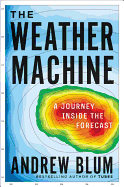
In 2012, Hurricane Sandy wreaked havoc on the Eastern seaboard, claiming hundreds of lives and causing tens of billions of dollars in damage. While the destruction was severe, it could have been much worse--the storm was predicted more than a week before landfall. This early warning was the result of weather forecasting, a relatively young science that is becoming increasingly accurate.
In The Weather Machine, journalist Andrew Blum (Tubes) uncovers the nuts and bolts that make prediction possible. The invention of the telegraph in the mid-19th century allowed people to describe and share the weather at their locations and to develop networks and establish patterns. Soon after, the Smithsonian displayed weather across the U.S. on a large map, while the British developed the synoptic chart that showed changes in response to a deadly storm, thanks to reports from farmers and sailors, respectively. In the early 20th century, Norwegian scientist Vilhelm Bjerknes used math and physics to hypothesize about weather patterns, laying the foundation for modern-day meteorology. Blum explores additional elements contributing to the weather machine: stations (including Weather Station Kurt on Newfoundland, the only Nazi incursion on North American soil), global satellites that crisscross the earth and apps that make longer-range predictions.
None of this would be possible if it were not for global cooperation among nations. Weather knows no borders. Yet, the technology that supports weather observation also supports military endeavors, revealing a conundrum: "We learned to see the whole earth thanks to the technology built to destroy the whole earth." With infectious curiosity and spirit, The Weather Machine is an engaging foray into the ingenuity that built the modern science of weather prediction. --Frank Brasile, librarian

